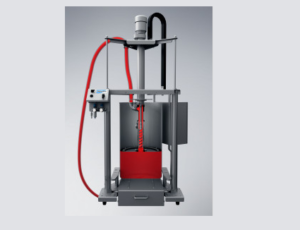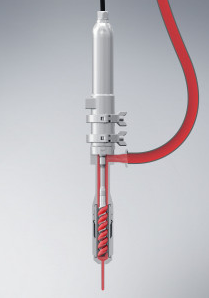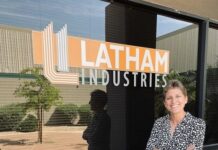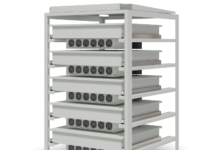
Production of Soft-Close dampers requires complex dispensing solutions
Wherever (vibration) energy has to be dissipated – i.e. where components move – dampers are often used to “buffer” this kinetic energy, e.g. using the viscous behaviour of liquids. The best example of the effect of large-volume dampers are structures embedded in bridge piers that compensate for earthquake vibrations using special hydraulic oil. Numerous examples can also be found in vehicle design or household goods, where users value excellent damping properties. Slowly closing car boot doors, gently sliding drawers or even toilet lids that lower gently are just a few examples of where dampers of all designs provide valuable service. To enable manufacturers to implement products with a soft-close mechanism until the dampers are filled, mechanical engineers integrate, for example, ViscoTec dispensing systems into their designs.
Just question of time: Bleeding of damper materials
To ensure that such a production line fulfils what the specification says, both the machine builders and the manufacturers of the soft-close products themselves frequently carry out advance tests at ViscoTec. Questions to be clarified then include, for example, the following: With which components ViscoTec, as a specialist for dispensing and filling systems and dosing components, can optimally convey the damper material from a barrel in order to perfectly dispense it in the next step. For example, it may be that different materials are to be used, which must be integrated into the production line. The challenge is then less the quantity of materials to be dispensed, but rather the different damper materials with different viscosities that are used in the production of the dampers. Highly viscous liquids always bear the risk of air inclusions – a natural degassing of the air bubbles from an oil is therefore always linked to the viscosity. If the viscosity increases, the material takes correspondingly longer to degas. Based on tests and the experience of countless successfully implemented customer applications for industries such as aerospace, electronics, biochemistry or pharmaceuticals, to name but a few, ViscoTec engineers then work together with the machine manufacturer to design solutions in which the material to be dispensed is filled into a ViscoTreat treatment system during the first step. It is then sucked out with the integrated pump and fed to a dispenser. Directly afterwards it is dispensed via the respective dispenser. The size, design and material filling of the dispenser are based on the end product. This gives each product the damping properties that best suit its size and weight. Individually and flexibly.

A constructive solution for flexibility
Different viscosities require separate dispensers. Although they are similar in design, they often require the machine builder’s own design in order to be able to switch between the individual dispensing stations. An example of this is the rotary table, which calls for such a specific machine design. In the case of the rotary table, one control system can be used for all integrated components. Therefore, in the first step, the dampers can be pre-assembled and then transported to the rotary table station, where the dispenser with the damping material, at the required viscosity, is located. This is followed by quality assurance, which is aimed, for example, at testing the damper performance (torque curve) and also monitors the entire process.


















